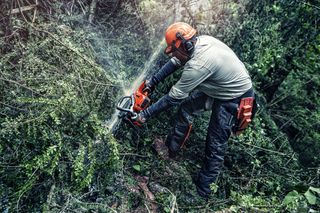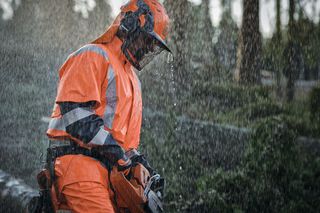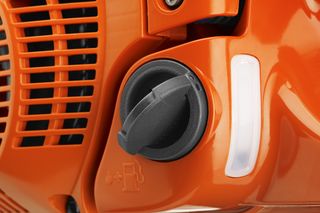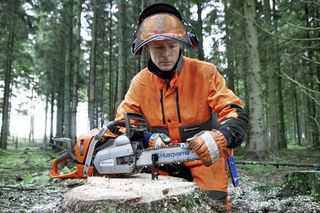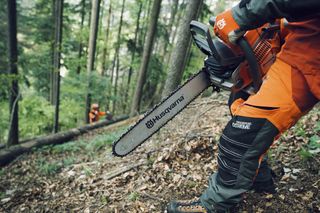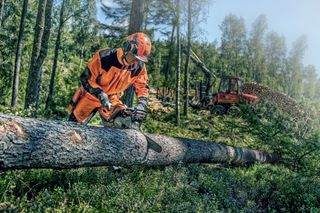
Prevent your chainsaw from getting stuck using the cross-cutting technique
Using a cross-cutting technique when felling trees not only increases safety but also prevents your chainsaw from becoming stuck. Using an incorrect cutting technique can cause the guide bar to become pinched or the trunk to split when you don't want it to. Spend a moment or two to assess the trunk before making your first cut. How much tension is there? And how does the trunk react when you begin to cut into it? When felling a tree, it is a good idea to plan where you want it to fall. Having the right chainsaw for felling is one thing, knowing how to use it where the skill comes in.
Safety First
When cross-cutting a log, you’ll need to be aware of the position that you are standing. Being aware of your surroundings and the terrain that you are working in prevents accidents. Some of the basic safety checks include:
- Stand uphill from the log when working on slopes. Logs can begin to roll before you have managed to cut all the way through which could lead to injury.
- When cutting into trunks they can throwback or jump. It is recommended to step to the side of the cut to minimise the risk of injury.
- Wearing protective clothing is a must. A pair of high-quality protective boots with saw protection can keep your feet safe should there be a slip of the hand. A pair of functional gloves with saw protection and heavy-duty work-wear is recommended.
- Try to avoid standing directly in front of the area that you are cutting as the chainsaw may kickback upon making contact with knots inside the trunk.
When it comes to working with chainsaws, you can never be too careful. Making use of PPE is always a smart choice. The following is a list of the best PPE to use while making cross-cuts with a chainsaw.
- Protective helmet with eye and ear protection.
- High-quality protective boots.
- High visibility protective trousers with saw protection.
- High visibility protective jacket with saw protection.
Functional gloves with saw protection.
How to crosscut with a chainsaw
To begin with, grip the front handle with your thumb. Run the chainsaw at full throttle before making the first cut. While you are working it is recommended to stand away from the chainsaw at a diagonal angle. Avoid standing directly behind the chainsaw to avoid injury from kickback.
To prevent the trunk from splitting it is advised to make a cut a third of the trunk’s diameter. This cut should be made on the side of the trunk that is going to be exposed to the most compression. This area of compression is also where the chainsaw’s bar will most likely become pinched.
Once the first meeting cut has been made you can continue from the opposite side of the trunk until the two cuts meet. To help facilitate the felling process you can make use of a felling wedge. A Husqvarna Felling Wedge will help the tree fall in the direction that you want it to.
Cross-cutting logs that are supported at both ends
If both ends of the log are supported, then it is best to avoid cutting it from above. When both ends are being supported, the stress and tension are placed in the centre of the log. Cutting from above will allow the tension to pinch and trap and the chain or bar.
Begin by making a cut on the top of the log that is an inch or two deep. This will help prevent the log from splitting. Next, directly beneath where you made this cut you can use your chainsaw to cut from the underside of the log and work up until you meet the top cut. Stand back diagonally from the log to prevent the heavy wood from crushing your feet as it falls.

Cross-cutting logs that are supported at one end
If only one end of the log that you are cross-cutting is supported, then the tension and stress will be focused on the underside of the log. This means that the cross-cutting should be performed from above to prevent the chainsaw from becoming pinched or stuck.

To prevent the trunk from splitting while performing the cross-cut, first make a shallow cut of one to two inches on the underside of the log. Using this as a guide, begin to cut your way through the log from the upper side until the two cuts meet. Stand off to the side of where you expect the log to fall to avoid injury.

How to free a pinched chainsaw
It can be difficult to work out exactly where the tension and stress will be on certain logs and trunks. Misjudging where the tension is can cause the chainsaw to become trapped. It is never a good idea to shake your chainsaw while the engine is still running. To do so could cause irreparable damage to your chainsaw and potentially fatal injury to yourself or others.
The best way to free a trapped chainsaw is to use a felling wedge or a crowbar to gently lift the pressure and tension of the tree off of your chain and bar. Before attempting to do this the engine should be turned off to prevent the chain from accidentally moving and causing damage or injury. While it can be frustrating, acting calmly and with precision will have it free in no time at all.
Using a chainsaw designed for forest work can help limit the risk of your chainsaw from becoming pinched or trapped. A professional chainsaw such as the Husqvarna 572 XP® is able to quickly and easily cut through extremely dense wood while providing you with maximum precision and control.
Why cross-cutting is important
The cross-cutting technique helps to prevent your chainsaw chain and bar from becoming trapped or damaged when felling a tree. By making the first cut when using this technique, you are effectively displacing the tension and preventing any accidental splits from occurring. By using a cross-cutting technique you have better control over which direction you would like the tree to fall.
When it comes to making cross-cuts in logs, looking at where it is supported will help you work out which way to cut. Logs that are supported at both ends will have tension running across the upper half. Logs that are only supported at one end will have the tension placed on the lower half. For logs laying on the ground, make the first cut halfway through the log from above and then roll it and cut through from the other side.

